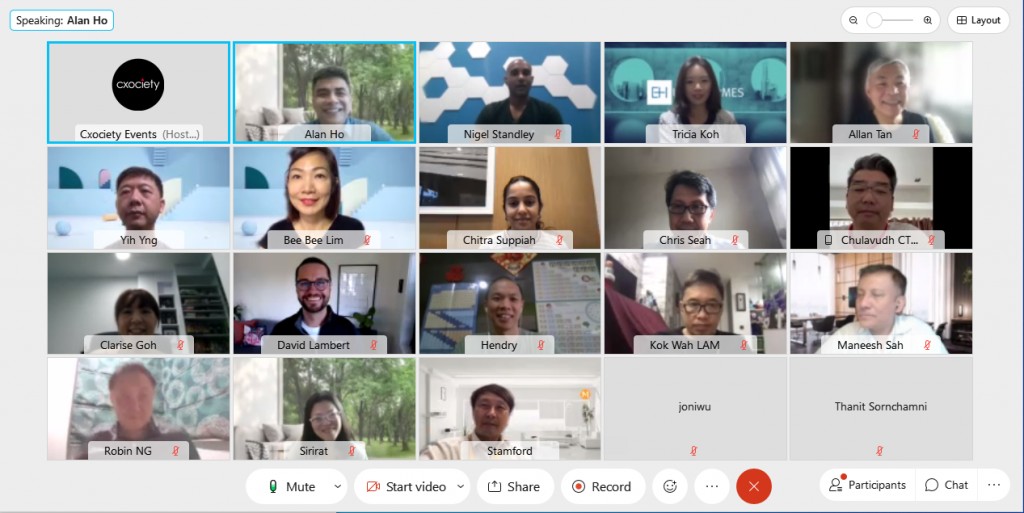To cope with restrictions due to the Covid-19 pandemic, companies accelerated the digitalization of their customer experience journey. With an increase in digital interaction between customers and businesses, companies are now eager to optimize customers experiences for engagement and business insights.

In a Cxociety C-Suite virtual roundtable discussion titled “Best kept secrets in sustained customer experience strategies”, co-hosted by Medallia, participants in Asia discussed some of the challenges and best practices in customer experience management for a post-Covid world.
Digitalization and touchpoints
Ninety-seven per cent of companies say that Covid-19 accelerated their digital communication strategy by 6 years, according to the Covid-19 Digital Engagement Report 2021 by Twilio. However, most participants found it challenging to manage an effective digital customer experience.

“Reach to our customers at every touchpoint is getting harder and harder and having a good digital customer experience is critical for us,” said Tricia Koh, regional market management director, Asia Pacific, Euler Hermes.
“Traditional touchpoints are all gone in the enterprise world,” said Robin Ng, customer experience director, Orange.
Enhancing digital customer engagement
To engage with customers, “we make sure customers get periodic updates and reviews and make sure we attend to their needs and give the assurance that they have our attention,” added Ng.

For others, “customer experience is about content that challenges our audiences with commercial insights and inspires them to think differently about their businesses. Customer experience is also about design which embellishes that content. Finally, it is about presenting content based on context using the most effective channels such as animated story pages in your website, and social video using tools such as Wochit. Also, during the pandemic, customer experience can be enhanced via virtual events enabled by tools such as ON24,” said Maneesh Sah, head of marketing and communications, Asia, Aon.
In 2021, the View From the Board of Directors survey by Gartner found that 58% of companies expect digital investments to significantly enhance their customers' engagement.
Challenges with data collection including PII

For the healthcare sector, the security of data is a key challenge. “It is still an evolving landscape - there is a lot of data but they are siloed. There is significant friction for data access between patients and the healthcare system due to internet surfing separation. When the healthcare sector moves into the healthcare commercial cloud in the future, this should improve,” said Dr Ng Yih Ying, head of digital and smart health, Tan Tock Seng Hospital.
Silo data can lead to different departments having access to different data and this may not give a true picture of the persona to lead to a satisfying experience. It also leads to some of the top challenges facing business in the Asia Pacific region such as building a customer-first culture (40%), linking CX initiatives to return-on-investment (38%) and sliced customer data which is incomplete customer profiles, disconnected customer experiences (34%), according to a 2020 InMoment survey.
Participants also discussed concerns of PII (Personally Identifiable Information) collection when companies need to know more about the customer to improve their customers’ digital experience.

“In many industries, especially those with higher regulations, need to think carefully about the data they collect, store and use about their customers,” added David Lambert, senior principal APAC, Medallia.
“PII data is one such data type. However, PII is not always required to build a successful voice of customer program, so don't let this get in the way of starting or evolving your CX efforts. Medallia is used successfully by organisations across financial services, healthcare and government with our highest level of data security and best practice solutions,” he explained.
Feedback to measure customer experience
To gain insights into customer experience, many companies use feedback forms. “We use feedback forms to find out the quality of the CX of clients,” said Sah.
“The traditional form of measurement is already a challenge. You want to know what they are experiencing but it must not be too overwhelming for the customer to get their true sentiments,” said a department head for a multinational banking institution.
“But customers in Asia are generally nicer. They give you a neutral response and you don’t know if you are meeting their expectations or not,” she said.
On the other hand, there is a need to balance the approach when reaching out to customers. “At the same time, we are very concerned that we burden them too much in that aspect [getting feedback from them],” she added.
Koh agreed. “Many of them are CEOs and CFOs and we don’t want to burden them with surveys. But we also do want to track their open rates of our emails and if there was any action taken after going to our landing page.”

However, “traditional SMS surveys do not provide enough depth to peel the onion to do the exact thing we need to do,” said Stamford Low Siew Sen, director customer experience & retail/ Data Protection Officer, M1.
“For specific insights, we have moved on to focused groups and face-to-face surveys. We find the increase in the quality of the insights we get and allows us to take much better actionable points than a mass survey,” he added.
“Asking for direct feedback via a survey is often the starting point for many companies, but it should not be the end-point. Survey response rates are declining, especially when customers don't see companies take action on their feedback,” said Lambert.
“Instead, companies should be integrating every piece of data they have into their VoC, and running actionable A.I. over that data to gain predictive insights and prescriptive actions for every employee to follow," he continued.
Future of CX: building trust and integrated data
Building trust with customers will be the future of CX. “When cookies go away in a couple of years and people will have the right to say I don’t want you to ever track me and they will have the ability to opt in to give you more information,” he warned.
“When that happens, customers will be able to determine which companies they share their data with. The companies who have built authentic trust with their customers will win that data, and others will be left guessing,” he added.
He suggested that the steps for companies to take now are to rethink how they use a customer's data.
“Those that use it primarily to sell more to customers are playing too narrow a game. Those who use customer data to also improve each customer's experience are on the right path,” concluded Lambert.





